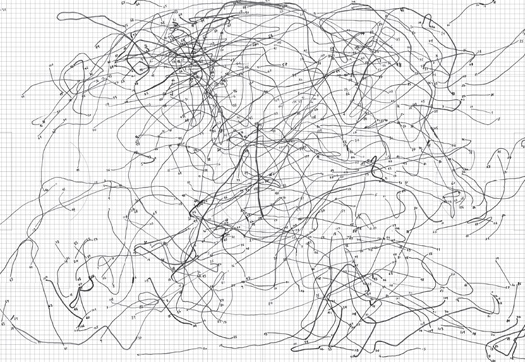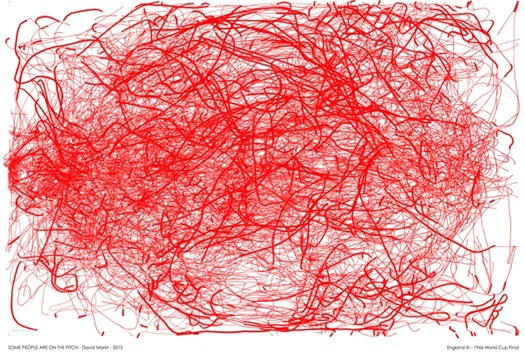
[‘Alan Ball — full match’, working drawing (ink on trace); artist David Marsh]
Just in time for the World Cup, English architect-turned-artist David Marsh has executed a fantastic series of drawings based on England’s (sole) World Cup finals appearance, their 4-2 victory over West Germany in 1966. Using archival footage played back at quarter- and half-speed in combination with a coordinate system derived from the markings on the pitch, Marsh traced the movements of each of the twenty-two players involved in the game (substitutions were not allowed in the World Cup until 1970) onto sheets of trace.
As I’ve previously talked about my interest in sport as a representative diagram of urban space — noting that the soccer field can be read both as an abstracted embodiment of a particular village landscape (a map) and as the site for the deployment of spatial strategies which mirror urban processes (a canvas) — it should not be surprising that I am fascinated by Marsh’s drawings, which essentially offer an architectural reading of a soccer match.

[“B. Charlton v. F. Beckenbauer”, David Marsh]
In strong contrast to the abstracted linearity of the live passing diagrams produced by the New York Times for South Africa or the Guardian’s (exceptionally informative) chalkboards, the resultant diagrams are willfully organic, being the strict record (their strictness and literal quality reminds me of record drawings and as-builts) of compromise between the wandering dictates of each player’s attention and the geometry of the soccer match.
Interviewed at Umbro’s soccer blog, Marsh suggests the obvious next step for his drawings, which is to apply the technique not just to the production of a record of a single match with historical significance, but to construct a library of games translated into ink strokes. Combined with a previous suggestion that Marsh has produced an architectural reading of sport, this suggests the possibility that there might be comparative architectural sports analysts, commentators and scholars who specialize not in narrative (or even tactics, though the English tactical analyst Jonathan Wilson is probably the most architectural sports analyst I’ve ever encountered), but in space and relationship and construction. (Here it might be worthing noting — as evidence for the validity of such an approach, or at least the existence of parallels between the endeavors — that, like architecture, sport has an ambiguous relationship with ‘art’, sometimes easily allowing itself to be read as ‘art’, and yet at other times just as thoroughly resisting that categorization.)

[“England only”, David Marsh]
I’d love to know what new insights into (and tools for understanding) sport such analysts might develop: we might learn, for instance, that — seen as a whole, like a finished building — the coordinated movements of Dunga’s Brazil possess a crystalline beauty to rival or even exceed the individual brilliance of the classic Brazilian squads of the seventies (a brilliance whose absence is consistently bemoaned in contemporary commentary); we might discover hidden threads of historical congruence like those that Wilson untangles in Inverting the Pyramid; or, a rogue Eastern European coach — formerly trained as an architect at the Cooper Union — spending caffeine-fueled nights pouring over countless overlays of matches played by each of his squad’s Champions League opponents, might spot hidden complexities in those opponents’ patterns of play which even their own coaches are unaware of and, exploiting that knowledge to maximize the effectiveness of his own team’s positioning, lead a Latvian squad of middling journeyman to the most unlikely of European titles, as they bewilder opponents by trotting out new and bizarre formations in each match.


[…] Space: Mammoth takes a look at soccer as a representation of urban space – a diagram of the strategies for using space. Very […]
[…] drawings of David Marsh capture the plays of World Cup Soccer to make visible the complex mechanics of the […]